This article is the second and final part of a discussion of the research by Dave Logan, Bob King, and Halee Fischer-Wright. If you haven't read the first part yet, you can do so here. These researchers defined five cultural thinking patterns in communities. In part one, I explained the first three of five thinking patterns. These communities are 20-150 people. I also suggested the responsibilities of an introducer-in-chief. This environmental thinking also refers to how the group behaves and how members talk to each other. To the researchers, each pattern has a identifying perspective:
- Community thinking pattern #1 (the most negative): "Life is miserable"
- Community thinking pattern #2: "My life is miserable"
- Community thinking pattern #3: "I'm great"
- Community thinking pattern #4: "We're great"
- Community thinking pattern #5 (the most optimistic): "Life's great"
In this article, I continue with their impressions of community thinking pattern #4 and conclude with thinking pattern #5 (the most optimistic).
Community thinking pattern #4: Environment
In this thinking and behaving community pattern, all five open organization principles of transparency, inclusivity, adaptability, collaboration, and community become extremely important to succeed, are actively applied, and are visible. In community thinking pattern #4, a community member transitions from personal gains to direct group or community gains as the focus. As the leader (introducer-in-chief), your role as a direct supervisor is less important than community member delegation. At this stage, you are not as powerful and productive as the total collective community.
According to the researchers, the roles of clients, suppliers, friends, mentors, and coaches are blurred at this stage. The people in your community form and focus on value-based relationships and identities. They cluster in larger, more transparent networking groups and develop community pride, as at this level, they focus on common community core values and interdependent strategies.
These communities are best formed by assembling like-minded, cooperative individuals who want to advance a specific communal goal. Community members are mostly already at a high individual achieving level, like those in community thinking pattern #3. The community ignores organizational boundaries when looking for community candidates.
In the researcher's words, "We're great," and indirectly, "Others are not" is the thought process. These "others" could be even different groups within the same organization.
Based on raw talent and high collaboration, this community can be powerful and hard to break. If the wrong (but talented) people are let into this culture, it could be hard to fix. Cooperation and transparency can weaken when the wrong choices are made. During the selection process, there are almost no organizational boundaries. It could explore "on loan" members from other departments, contract or part-time workers, contributors, volunteers or free agents, or anyone dedicated to the community purpose.
Regarding collaboration, a community at this stage feels comfortable interacting with other community members only. If invited for a cup of coffee, these community members consider asking at least two other people to come along to get collaboration casually started.
When the team hits difficulties, they seek out where solutions might be found. To do that, they seek diverse parties and ideas. They continually review and discuss:
- What is going well.
- What is not working well.
- What the community can do to improve things.
Feelings within early community thinking pattern #4
Only community members who are individually successful in their specialty can move to community thinking pattern #4. If they have not excelled in their field, they come across as weak when they attempt to jump to thinking pattern #4.
Moving to community thinking pattern #4 requires group interaction and cooperation, not just individual talent. Therefore, open organization principles are needed, namely:
- Building communities to achieve more.
- Inclusivity of others (not just doing things alone or one-on-one giving directives and assignments).
- Adaptability to a new style of getting things done, collaboration, and transparency.
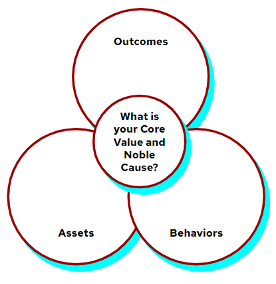
Modified by Ron McFarland from the researcher’s material (Ronald McFarland, CC BY-SA 4.0)
To advance to a community thinking pattern #4 culture, you must begin with the culture's core values and noble cause (center). These are presumably compelling to everyone in the community, or else they wouldn't join in the first place. Next, move to the outcomes (completing a series of doable, measurable tasks at a predetermined time, leading to a specific goal). Finally, acquire the assets required to accomplish the tasks.
These questions come up:
- What assets do we have right now, and what do we need to achieve the outcome? These could be equipment, technology, land, relationships and network, education, skills, goodwill, brand, public awareness, reputation, culture, or drive/passion.
- Are there enough assets to achieve what we want?
- Will the community's behavior accomplish the desired outcome?
The leader must consider the community's current culture and thinking to answer the above questions. Considerations include:
- Who is in the community?
- What do they care about?
- What are they working on?
- What does everyone want?
- To support members, who can I introduce them to?
A big difference between community thinking patterns #3 and #4 is that you, as the leader, must move away from the desire for personal success and redirect your attention to the community's success. This requires you to give up some control and rely on the community members to work with each other directly, make their own decisions, and accepting accountability for their actions. It starts with introducing two members to each other to address a common objective jointly.
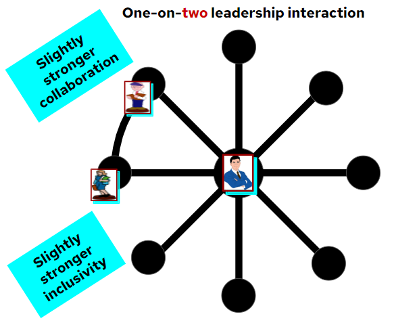
(Ronald McFarland, CC BY-SA 4.0)
They start working in gatherings of more than two people (beginning with three, including the leader). Sometimes you introduce two people to each other that might be suitable to work on an issue. You slowly exit the discussion and allow them to take over. Get out of the way and let your team members work directly with one another.
Feelings within middle community thinking pattern #4
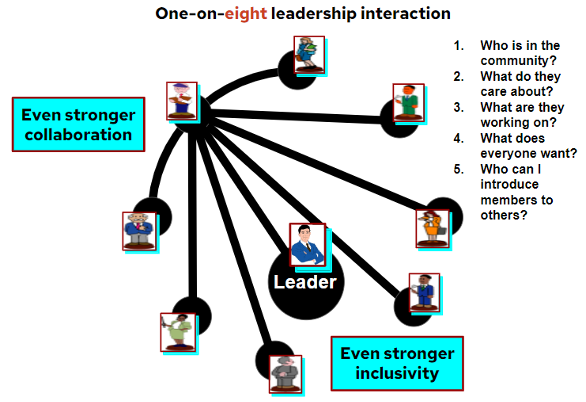
(Ronald McFarland, CC BY-SA 4.0)
After getting two people working on tasks together, you can start introducing more members with specific functions in mind by continually asking those same questions, starting with "Who is in the community?"
These introductions strengthen the community, increase collaboration, and widen inclusivity.
Feelings within late community thinking pattern #4
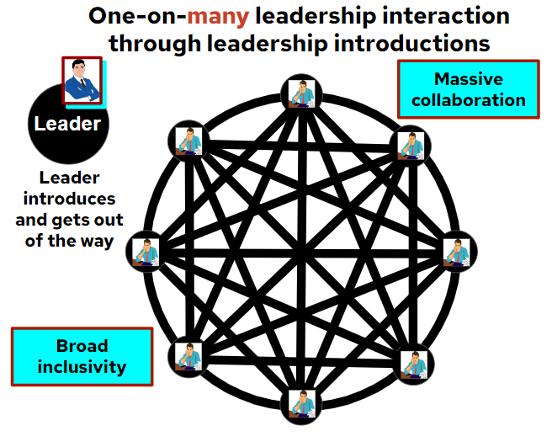
(Ronald McFarland, CC BY-SA 4.0)
After members start working with each other on specific tasks that lead to desired outcomes, a high level of inclusivity and collaboration results. This increases community productivity to a globally superior level, leaving all competition behind in their market.
After identifying the community's thinking, behavior, and language, your action plan is to explore challenges that your team can't work on without involving outside help. Your goal is to find outside collaboration that encourages community thinking pattern #5 culture. This approach is needed when the community has been so competitive that they need a new, more global challenge.
Where once community thinking pattern #4 competed with other communities, now your community is willing to cooperate and collaborate for the overall greater good. This cooperation leads to a more enjoyable working environment. You must encourage and praise your community members every chance you can, and redirects personal praise directed at you to your community members.
Community thinking pattern #5 environment
People with this thinking pattern feel "life is great," according to the researchers. The members of this community have the same pride as thinking pattern #4, but without the competition. Conversely, they hope to collaborate with other communities to achieve a higher calling, like addressing climate change, cancer cures, avoiding war, overcoming disease, or hunger elimination. They seek other communities that have been extremely successful and have similar goals, objectives, and desires.
While in community thinking pattern #5, an organization is so successful that it has no need or desire to compete with other communities. Just competing bores them. A leader in community thinking pattern #5 is rewarded by community trust building, hard work, innovation, and collaboration. You are less interested in direct, personal rewards and praise, and more interested in boosting community, inclusivity, and collaboration.
Feelings within community thinking pattern #5
In this community thinking pattern, people are very successful. They're so successful that there is no more competition or desire to compete with others. Instead, they turn more toward vital, global, philanthropic goals. Most financial desires have weakened, because they have accumulated far more assets than they ever would hope to need. They have lost the desire to "win" against others and want to channel energy toward a higher goal.
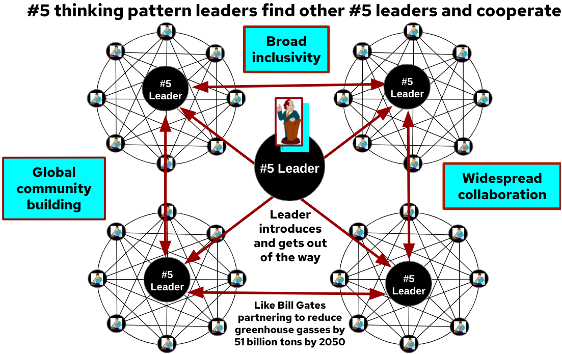
(Ronald McFarland, CC BY-SA 4.0)
Community thinking patterns in action
This is a fictional story of a man named Bob, a man who experienced all community thinking patterns from 1 to 5 (which few of us do).
Community thinking pattern #1 to #2
Imagine that in Bob's early life, he was abandoned by his family. As an orphan, he grew up in an unsafe environment, and had no one to encourage him to achieve anything beyond basic survival.
You meet Bob by chance, and after getting to know him, you tell Bob that you might be able to help him out. You are the introducer-in-chief.
First, you introduce Bob to Carol, who works as a janitor in a software development company. Carol says she could get Bob a job at this software company, as long as Bob can meet the basic requirements of the position. These are relatively basic requirements: Show up on time, do the work, and so on.
While Bob is doing janitorial work in the software company, he asks some of the code writers and programmers about the work they do. David, one of the programmers, is excited by Bob's interest in software development. He asks Bob whether he'd be interested in learning to program. Bob says, "I've always liked to do troubleshooting work and puzzles, so why not?" So David introduces Bob to a wide range of online software development tutorials. David is a secondary introducer-in-chief for Bob.
Bob studies on a spare computer there in the company during his spare time. Mentoring him along, David starts to see real talent in Bob, so he introduces Bob to his college professor, Evelyn. Evelyn also sees the talent and drive in Bob, so she counsels him on how to develop his skills further.
Community thinking pattern #2 to #3
Bob proves himself to be a skilled programmer. Over time, his programs become more and more popular. He starts coding for money as a contractor, and as time passes he needs a staff to handle orders coming in. As sales come in, ideas for new programs materialize as well. He has so many ideas that he's overworked. He also hires staff to do programming, but he controls their assignments and tasks very closely. Even though all he's doing is supervising them, he's mentally exhausted at the end of the day.
Community thinking pattern #3 to #4
Bob goes back to Evelyn and asks what to do. Evelyn introduces him to Francis, an open organization consultant for small teams. Francis instructs Bob to get developers to talk to each other more directly, and let them come up with their own solutions and projects. Francis tells Bob that he has to let go of day-to-day supervising operations and start thinking about the overall operation of the team.
Over time, just like explained in the book Team of Teams, a well-oiled highly-efficient operation is created.
Community thinking pattern #4 to #5
After decades of massive successes, Bob has achieved more than his wildest dreams. His desire to be the best and beat all the competitor weakens. Bob wants to give back in a way that is most globally helpful. He starts approaching people with the same desires and meets Jeff, a global open organization project manager. Jeff specializes in global, multinational, long-term challenges like climate change, global green energy generation, energy waste reduction, food waste reduction, cybersecurity, international relations, world hunger, global migration and many others. Through Jeff's introductions, Bob starts a wide range of multinational projects. Again, just like in the book Team of Teams, Bob has gotten global teams collaborating to address really difficult, long-term challenges. Finally, Bob is at peace knowing how much he has achieved and will continue to achieve well into the future.
What community are you in?
In your working environment, think about its greater purpose, and consider membership listening quality, problem-solving quality, ongoing job support, and participation level. Rank those factors from one to four and consider where development is needed. On average, a 3.5 would indicate a competitive thinking pattern #3 community and 4.5 an internally collaborative thinking pattern #4 community. To confirm the group thinking pattern level, also ask yourself what general feeling sticks out among most members:
- Life is miserable
- My life is miserable
- I'm great
- We're great
- Life's great
Armed with that information, consider what action is required.






1 Comment